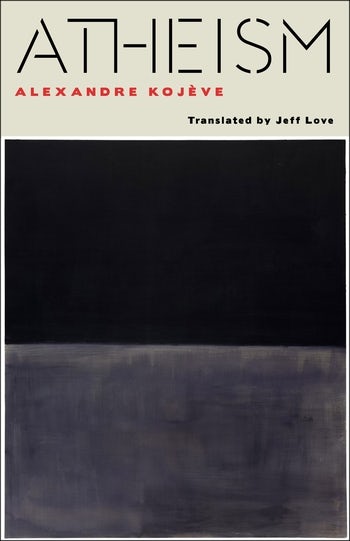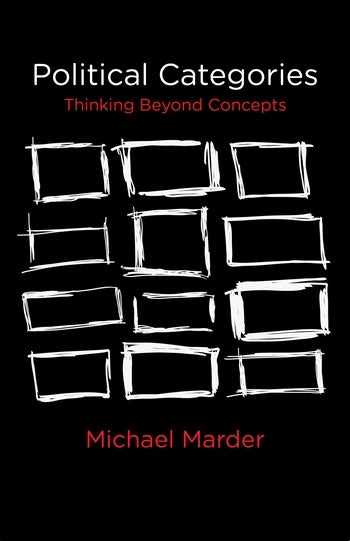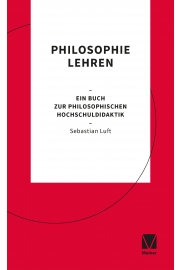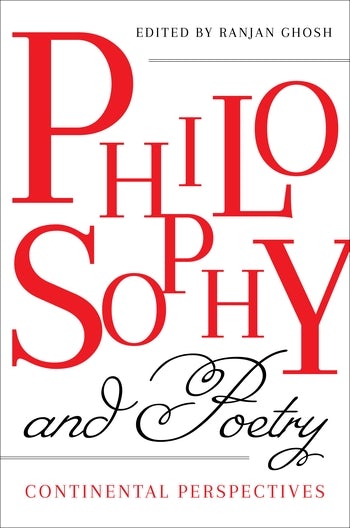 Atheism
Atheism
Columbia University Press
2018
Hardback $32.00 £28.00
248
Reviewed by: Hans Krauch (Canada)
This work was compiled from an unfinished essay originally written in 1931, a part of the vast trove of documents left behind by Alexandre Kojève that publishers are finally starting to take out and disseminate to the world. At the time this was wrote, atheism was not just blindly implemented by Soviet ideology, but it was the sign of the final death throes of faith in its fight against the Enlightenment movement. Indeed, the Enlightenment proved victorious, though it was a Pyrrhic victory as the Enlightenment movement itself died with the Soviet Union in the last decade of the 20th century.
The introduction does a very good job at going over the general points of the book – and indeed the author of the intro is quite right to say that it does not take away from the joy of reading the original work. The work reads like is a man struggling with these very difficult concepts, at a time when these concepts were shaping nations. Knowing the topics of atheism versus theism meant knowing the bloody history of the 20th century – with its creation and destruction of empires, nations, and people’s lives numbering in the hundreds of millions.
The topic of atheism was not merely academic as it had real world impacts, so one could detect the urgency and importance of the topic in the tone of Kojève’s writing. To be sure, the true philosopher is one that realizes that their work has real world implications, that it is important to all people – not just relegated to the world of academics. In this spirit, Kojève can be understood to meet that criteria of philosopher quite easily.
Atheism is still quite prevalent today, and this book will shed light on today’s stance on this belief of non-belief in a way few else can. Kojève was there when the contemporary atheism movement begun and therefore has insight that contemporary academics cannot understand. Kojève separates people into two camps – the theist and the atheist. Of course, most of us fall somewhere in between these two camps, but in order to properly understand either he has boiled down the types into purities, then compared the differences between the two.
Kojève was not particularly interested in promoting one side or another, merely trying to figure out what they were and where they base their particular life-axioms. From the spirit of the book, the best Kojève (or arguably anyone) can do is speak about both sides in general terms, mostly because the main concepts held by either side is, at best, understood in general terms. He divides further the concept of the theist and atheist as ‘qualified’ – this would be one whose ideologies are solidified, extreme, and self-aware.
The qualified theist is one where God’s existence is simply accepted, and there is nothing more to say on that. God is understood to be a thing with some kind of quality, a thing that makes God a God. But, is God a ‘thing’? Indeed He is, however it is a thing that is very different from other things – other things that inhabit the material realm. Therefore, a qualified theist is one that understands that God(s) have predicates.
The theist is a person who believes in God, whatever that may be, and the atheist does not believe in God, whatever that might be. That being said, faith itself is considered irrational, so both the theist and atheist are more similar than they would like to admit.
The basic question asked in this work, though cannot be answered definitely, is “Is it possible for the atheist to claim that there is nothing beyond the world without entering into contradiction.” (Kojève 2018, xvii). The atheist is the one that mostly uses rationality as their basis of belief, but on what basis can they claim to be more rational than the theist (if proving the existence of God is unfalsifiable)?
For Kojève, how people believe to interact with the external world is very important to his conclusions. Firstly, we have the human being in the world – this is one that interacts with the material world. The concept of homogeneity is used, and this is to give us the notion that our own experiences are similar enough amongst other humans that we can all assume that we interact with the world in more or less the same way so that it can be described in general terms. Homogeneity is the concept that things outside the self are similar enough for us all.
The concept of estrangement is that it only applies to human beings, and that the world presents itself to us and as such we cannot escape from this world and remain sane. Kojève posits that things are ‘given’ to us, but it is God that does the giving (for the theist). The theist is aware of this stuff given to us and therefore suffers anxiety. The atheist cannot care less about such things and therefore suffers not.
The big question in this work is how can God reach thorough the realm of the outside world into our plane of reality? It reminds me of the difficulty of passing from subjectivity to objectivity – are such things possible and how can we do this without sacrifice of quality?
Kojève’s greatest accomplishment in this work is the position on death itself. He posits that we all agree that there is a passing to an outside world, to some degree, when we die. This is simple enough to grasp as we can witness the death of others. Where things become complicated is when it comes to understanding our own deaths, because we can never experience our own deaths (as it occurs after we lose consciousness, and consciousness is the sense that enables the other senses to process external information). The concept that we cannot imagine our own demise or nothingness is very important, and one that is ought to have the highest dissemination to the world as possible.
Death is both nothingness and thingness at once, which is similar to the problem of the existence of God: “Death is thus available to us only in its unavailability, as unavoidably enigmatic, the genuine, essential, and ineluctable mystery.” (Kojève 2018, xxii) This is the basic human condition. How we deal with that differs on whether or not we are an atheist or a theist. All of us face death with horror, in one way or another. This is why the medieval art featuring people facing all kinds of horrible violent deaths with a stone, uncaring face is seen as ridiculous rather than pious, to contemporary minds.
Where Kojève goes wrong is his stance on suicide. For him: “…suicide is the highest expression of freedom.” (Kojève 2018, xxiii) He is not technically wrong, as overriding our own self-preservation instincts requires a strong will, but the problem is that if we cannot fully comprehend our own demise or nothingness then how is this freedom? In suicide we aren’t merely experiencing the unknowable, but forcing it on ourselves. We shall explore this topic further near the end of the paper.
The theist sees death as the release of the soul from the body. The atheist sees this as simply being done with the world, and just wants to be done with living within it. Most people believe in a little bit of both theistic and atheistic aspects of death.
Regarding suicide, is it overcoming pain and fear, or is it a submission to it? There are those who survive suicide attempts all the time, so do know this we would have to ask them. Suicide is also prevalent within other species – there are well documented cases of animals drowning themselves or stop eating until they die, after they lost a mate or suffered some other tragedy. That being said, all the problems with our own lives end with our lives, for better or worse. That doesn’t mean it has no effects on the living, however.
This problem is similar to God the infinite – another concept that cannot be proven. The infinite, for Kojève, is the surpassing of limits, yet no such thing is possible because there is only the finite: “No attempt at liberation from the world is possible. Our interaction renders us vulnerable, limiting our freedom and ultimately tying us down to death. If Kojève were to say that only a God could save us, it would be that God achieved by Kirillov in suicide.” (Kojève 2018, xxv) If life is such a burden then why would we want to be free of its limits? Satisfaction is found in the conquest of limits, with no challenges to overcome then nothing is there to look forward to, an existence without purpose or meaning. Perhaps the true freedom is not freeing ourselves from limits, but from the shackles of fear of not overcoming limits.
Kojève is quite correct that both the atheist and theist want to break out of our obvious limits and achieve greater things, outside the world (or our perception of it). He is correct that speculation cannot provide proof, but this is the beauty of philosophy. We deal in matters that cannot be proven objectively, and in the absence of objective (material world) proof it is the best we have. The same goes for knowing when to mark the proper end for ourselves (like Hegel’s ‘End of History’). This question, I believe, is the same as understanding our own deaths/nothingness. Our end is the end of life – therefore to go into understanding that we need philosophical speculation to take the first steps towards knowledge.
The concept of courage in the face of death is described as simply a cover up for our own fear. Indeed that is the definition of courage – doing something in spite of a strong feeling of fear. It must be stressed that fear will always exist, so denying it exists at our own deaths would be inauthentic. So, an atheist would be one that feels they are ‘honest’ in the face of death – that after their body dies that is the end of them forever. The theist would be one that ‘hides’ behind hope that there is some kind of life (existence) after death.
Kojève is quite right to posit that an atheistic religion can exist if they limit themselves to believing in a non-existent nature of whatever God other people believe in. It is a matter of belief in the unfalsifiable versus the non-belief in the unfalsifiable, which brings us to another very interesting point in Kojève’s work – the discussion of atheism or theism does not belong within the realm of religion. This discussion goes beyond the confines of religion to encompass the foundations of how we think – logic.
Kojève’s work does bounce back and forth between concepts, as if he is having a conversation with himself – talking himself into a position, then thinking himself out of it. He understood that the atheist/theistic world views encompass the types of world they live in, and to understand those views properly is not so simple. At this time it would be appropriate to interject into the rather odd style of writing used by the translator. Obviously the translator has a firm grasp on the material, however there are some irregularities that would require some clarification.
For example, Love refers to God as ‘him (Kojève 2018, xxxii)’ when the proper way to refer to God is Him. Love later quotes Kojève as referring to God as Him (Kojève 2018, 15), so the grammatical inconsistency must have been known. It is not a catastrophic inconsistency, just one that peaks me to ask why such a thing was done in the first place. The other is the choice to refer to the generic person as she. Indeed, in the past ‘he’ was usually used, and this style of using ‘she’ is certainly en vogue these days, for whatever reason. I would have recommended to get away from any gender specific pronouns, if one’s goals were to avoid appearing sexist by using only one pronoun in particular over another.
The terms used are much appreciated, like ‘giveness’, but understand that these are not translation errors, but an expression of how a Russian or Frenchman in the 1930s would express such concepts of being an animated meat robot inhabiting a class M planet within a finite universe composed of matter and energy – and with all those things that go along with that. Another language oddity here is the usage of the term ‘tonus.’ The use of it here does not match the English dictionary definition of the word; being “The normal tension of a muscle at rest.” (Merriam-Webster 2019, 1) – unless Love is inadvertently using the French word tonus, which is tone in English, and in that case the word ‘tone’ works just fine in the contexts of this text. All that aside, we may now return to the text itself.
Concerning death and giveness, Kojève prompts some very interesting ideas. For example, Kojève himself is quite dead today, yet his words still reach out to me when I read his works – so in a way he is not truly nonexistent in the same way his body no longer functions. This paradox of ‘giveness’ Kojève talks about is quite interesting, perhaps we may need to accept this paradox as insolvable. We cannot have a conversation with Kojève, as we can only read, listen and reflect on his works. Kojève’s giveness continues after his physical death, but the living cannot present their giveness to him (in a way that affects himself as a living thing). That is, the dead can give to the living, but not vice-versa (unless we count the living keeping the memory of the dead alive, this can be a sort of giveness, but what is it – the dead giving to the living or the other way around?). This may not be solved, but at least it is something that will require more study in the future.
As far as we can understand life and death, death is seen at the destination at the end of all life, but this is not as important/valuable as the journey. Skipping ahead to the destination (by dying early) does not do anyone any favors. Journeys require destinations, but the destination itself gives little value in comparison to the experience of the journey. For example – there is little value in simply getting 100% on a test if passing it required no learning or effort. Indeed: “Life is not death, but without death there is no life.” (Kojève 2018, 61) Therefore, death is the impassible limit on life, and without limits there is no life. Therefore, we need limits in our lives for them to be considered lives. Finitude is necessary to complete our concepts of life. Additionally, one’s death is not entirely valueless – one may die well (self-sacrifice), poorly (by killing innocent people along with themselves), or everything in between.
Where Kojève goes awry is on his stance of suicide. On one hand, the concept of non-existence is unthinkable to a person, yet: “Suicide is the conscious and voluntary end of the existence of the human being in the world.” (Kojève 2018, 82) So, how can anyone consciously and voluntarily enter into a state of existence in which they have no possible way of understanding it? A contract is not considered valid unless both parties understand what they are agreeing to, so the person committing suicide is entering into a contract where they have no possible means of understanding it. If one is unable to know what one is agreeing to, then that is hardly a decision one are capable of making.
This is why we have laws against underage drinking or sex – the individual may be physically capable of drinking beer or having sex, but we have learned that under a certain age of mental development people are unable to understand the consequences of those types of behavior. Therefore, by granting any kind of positive attributes to suicide is at best naïve and worst morally repugnant as we know that there is no age in which we can be mentally competent enough to know that killing ourselves is the right choice.
Indeed, our freedom is linked to our finitude, both in the idea that yes we can drop dead at any moment and for a myriad of reasons. I believe Kojève is saying that we can understand that we are mortal and can die at any time, but at the same time not truly know what it is like. The freedom we have in life is knowing that there is an end, so we have this motivation to act in the here and now. If we were immortal – what would be the rush to accomplish anything? Free from the shackles of immortality, we strive to learn, to extend our ‘giveness’ to the outside world.
The concept of death and suicide aside, Kojève does a marvelous job of placing atheism and theism within their proper spheres. Both sides pride themselves on their differences, but they are actually more alike than they would admit, and Kojève puts them together enough so that dialogues can be opened: “By equating the non-atheist with the theist, I have identified all of what is not the world with God or, better, with divinity.” (Kojève 2018, 98)
Kojève is correct to posit that one’s atheism or theism infuses itself into their very work – most importantly into their science or philosophy. It is a far too common occurrence for people to assume that because they do a thing for a paycheck, the particular ideology they prescribe to will not affect their jobs in anyway. Every time someone kneels on the prayer mat, or consumes the host wine, or stands at attention to the national anthem – are strengthening their own ideology – and through it will influence the way we perceive and act within the world in a way they cannot be aware of. Atheism or theism is an important part of one’s ideology, and since ideology is the unseen mover that shapes peoples thoughts and actions, then it is fair to say it influences everything we do or think.
Both the theist and atheist feel the other is lacking in something and do not truly understand the other’s position. The theist has as a part of themselves that is something outside the material realm, while the atheist does not. Kojève is right to claim that secularity and religion is not the same realm of understanding as atheism and theism – as those are matter of logics. Religion and Secularism play by their own rules, by that they have their own axioms that fall outside logic itself. Christian religious studies simply assume God exists, and from there all their work goes from that point. The same for atheistic works – they assume no God exists and from there all conclusions are reached. Kojève’s conclusions predate either and seek to understand where both views originate.
On further study – it would appear both are closer to the realms of religion than logic: “…the God of science is not the same as the God of religion, this is nonetheless God.” (Kojève 2018, 122) Better understood, however, is that the beliefs of both atheists and theists are within the realm of religion, but the particular values of each are understood in the realm of logic.
We cannot describe either position exactly, as there are varying degrees of theist and atheism most of us hold onto. Still, Kojève does a good job in describing each as best as humanly can. All in all, this was a fine introductory text to Kojève’s positions on death, suicide, atheism and theism. Additionally, even those unfamiliar with his other works can enjoy this text as an introduction to these concepts presented here. Indeed, I would recommend it to anyone interested in these topics as a foundation to further study in the matters at hand.
The only drawbacks to the text are the few oddities of language usage, and that the text itself does not give us more. It is as if Kojève was wise enough to have the concrete answers on what it means to be atheist and theist, but is hiding it from us – so we are wanting more (if we can call this a drawback). A truly successful paper in philosophy, like art, is one that sparks the imagination, encourages debate, and leaves us open to a new slew of problems that we were previously unaware of. Considering these criteria, this book is a resounding success.
Bibliography:
Kojève, Alexandre. 2018. Atheism. Translated by Jeff Love. New York: Columbia University Press.
“Tonus.” The Merriam-Webster.com Dictionary, Merriam-Webster Inc., https://www.merriam-webster.com/dictionary/tonus. Accessed 9 December 2019.






